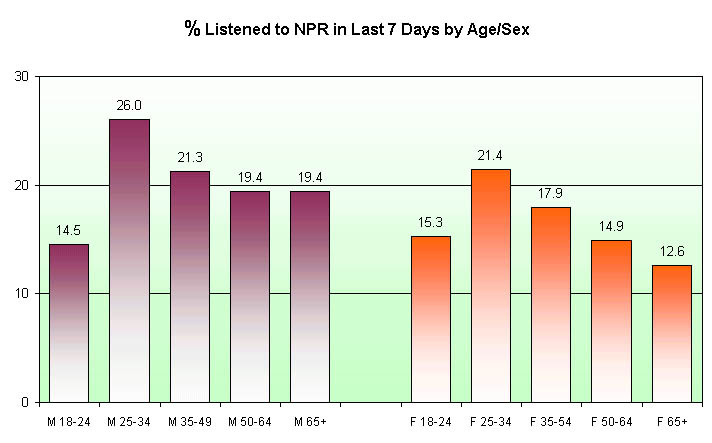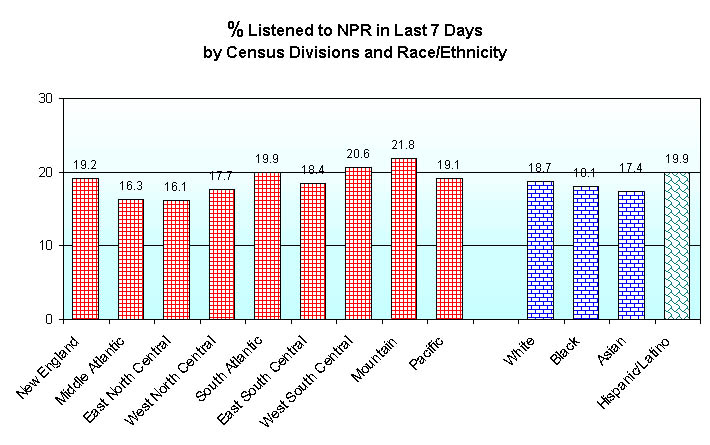
(Source: MARS 2002)
National Public Radio in the USA
In most countries of the world, radio is dominated by commercial companies whose operating revenues are primarily derived from advertising sources. As such, the business model is premised upon attracting mass audiences. Even though radio program audiences are often narrowly segmented (e.g. music programmed towards males 18-24 years old), the principle is nevertheless to obtain the largest possible audiences in those segments.
Unfortunately, commercial interests have the tendency to result in programming that is often characterized as being bland, simplistic and boring. Deep, careful analyses are rarely present because they cost too much to produce compare to just playing top 40 hits or letting listeners vent their opinions on talk radio. Controversial subjects are avoided at all cost, lest listeners get offended and organize boycott campaigns against advertisers.
In some counties, the void unfilled by commercial radio is taken over by government-sponsored public radio agencies. This has not been a universally successful formula, since it is difficult not to politicize these entities. In the so-called democratic countries, the governments have been elected for a fixed term and their actions and positions are constantly criticized by the opposition. A government-sponsored radio agency should not function as a mouthpiece for whoever is in power at the moment, since the agency itself would be controversial and divisive.
In the USA, the first radio broadcast took place in 1920. But it was fifty years later, on February 24, 1970 that the private, non-profit National Public Radio (NPR) was created as a national production center for news/information, cultural programming and program distribution. Today, there are now almost 700 local radio stations in the USA that receive and send radio programs through satellite. NPR Worldwide is also available in Asia, Australia, Europe and Africa.
The mandate of NPR was to provide "programming that will be responsive to the interests of the people." The largest public radio stations are WNYC AM 820 and FM 93.9 in New York City, whose mission statement is: "To make the mind more curious, the heart more tolerant, and the spirit more joyful through excellent radio programming." A radio station such as WNYC draws its revenue through three principal sources: individual tax-deductible memberships, corporate sponsorship and donations/gifts from foundations and individuals. These financing mechanisms are premised heavily upon the themes of "independent voice" and "listener support."
The key attractions of NPR can be found in the American Radio News Audience Survey:
NPR listeners produced a long list of likes about the public radio service. Likes identified by more than five percent of listeners included: coverage (19%), informative (18%), news in general (16%), topics (14%), opinions/perspectives (11%), programs/format (10%), specific programs (9%), accurate/reliable (7%), personalities (6%). Additionally, five percent of listeners cited few or no commercials; four percent suggested that they like NPR because it's entertaining.
Examples from the major categories of NPR likes include:
Coverage (19%)
Informative (18%)
- "It covers topics that I'm more interested in. It seems to be very comprehensive coverage of the issues."
- "It keeps me informed about what's going on in the world around me. They have good coverage of news stories."
- "I like the way they present the news. They spend enough time on each issue. It's not usually condensed."
News in General (16%)
- "They provide an excellent amount of information and are intellectual. More commentaries."
- "It's thoughtful. It treats me like a thinking man, a literate man. It covers a wide variety of issues that I find interesting. More emphasis on national news."
- "I like the information from the news. The stories are varied. The foreign news is interesting and they go more in-depth.
Topics (14%)
- "Getting the weather; getting information about the rest of the country."
- "They cover from state to state and I can get the news from all over the country."
Opinions/Perspectives (11%)
- "It covers topics not covered by other stations and the different perspectives."
- "More of a forum type of way of presenting the news. They touch on a wide variety of topics."
Program/Format (10%)
- "It gives a little different perspective than local city news stations and a more professional complete analysis of the story."
- "Different views and opinions."
Specific Program (9%)
- "Format is different than the average station."
- "It's just a clean, family-oriented format. That's it."
Accurate/Reliable (7%)
- "I like to get the news and grain market."
- "Our national news, crop reports, overseas and the weather."
- "I feel their coverage is thorough, objective and accurate."
We will now cite some survey data from the MARS (Multimedia Audience Research Systems) study. This is a mail survey of 22,097 adults (18 years or older) in the 50 states of USA conducted in the first quarter of 2002. Within this survey, there was a question: "Did you listen to NPR (National Public Radio) within the last 7 days?" 18.6% of the survey respondents said that they did so. On a population basis, this translates to 38,906,000 listeners out of a population of 205,060,000 adults.
The appeal of NPR was never intended for a broad mass audience. Rather, it is designed to appeal to specific segments who are otherwise not well served by commercial radio. In the following, we show three different charts of NPR listenership by different geo-demographic segments.
In the first chart, we show NPR listenership by age and sex. NPR listeners are more likely to be male than female, and their strongest age group is 25 to 34 years old.

(Source: MARS 2002)
In the second chart, we show NPR listenership by socio-economic characteristics. NPR listeners are more likely to be professional/managers, better educated and more affluent. Although NPR is not about explicitly commercial in the sense of flooding airtime with radio commercials, it nevertheless depends on individual contributions and corporate sponsorship. The fact that NPR listeners are more affluent implies that they can contribute significant amounts, and so the task is to persuade them to contribute to sustain the radio programs that they like. For corporate sponsors, the NPR audience represents a highly desirable elite audience that may be difficult to reach otherwise. The affinity of these people for NPR is easily transferable to the sponsors.

(Source: MARS 2002)
In the last chart, we show the NPR listenership by geographic divisions, race and Hispanic/Latino origin. NPR was never designed as a top-down system that allocates radio stations uniformly across the land, and so it is perhaps something of a miracle that this spontaneously self-organized network is reasonably evenly distributed. This speaks to the fact that there is demand for NPR programming in all parts of the country. And even though NPR has no specific racial or ethnic orientation, it also manages to be fairly popular across these groups.

(Source: MARS 2002)
The National Public Radio model can be considered to be fairly successful in the USA. But this is a phenomenon that came about from the unique set of historical and social conditions in this country. This model is probably quite unworkable and even unthinkable in most other countries of the world.
(posted by Roland Soong, 7/15/2002)
(Return to Zona Latina's Home Page)